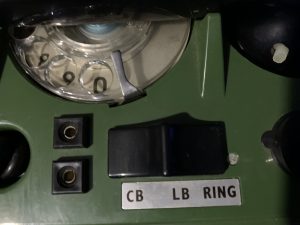These are more for fun rather than serious use. I had seen them in movies and on YouTube, and I just fancied a go with them! The ones I have are the UK PTC 405 (a.k.a. Pye TMC Type 1705 or the Linesman Telephone 1705). Manufactured by Pye TMC Ltd, these handsets were in use by the British Army from 1970’s to the early 2000’s (although this needs clarification, as its tough to get exact dates). We currently have 3 of these in all – 2 army versions with no dial in the middle, and one Linesmans handset which has a numerical dial in the centre for use with a switchboard or for line testing (possibly testing normal phone lines – again, this is a guess at present!). One of the army units does not work correctly – it will connect and ring in/ou, and you can talk to the other person but the speaker in the earpiece does not receive anything when connected (but unconnected you can hear your own voice in said speaker). I aim to fix this!

They are very handy units, self-contained within a plastic case that has a locking catch and a webbing strap. The lid is also held in place by green webbing when it is open.
Each set runs off three D cell batteries, and are not Hand Cranked as the original Field Telephones used to be. They are connected by two wires that screw into terminals on the right hand side of the unit. I discovered that any decent wire will do, and I personally use some heavy duty speaker wire. There is a sliding switch with the label ‘CB LB RING’ on it. Leave the unit in the ‘CB’ (Battery Out Of Circuit. It may also stand for Central Battery – but this needs confirmation) position at all times. Slide it forward to ‘RING’ to call another set, and if you are the caller, let the switch slide back to ‘LB’ (Local Battery) setting whilst talking, and leave it there during the duration of the call. The call receiver leaves their set on ‘CB’. During a call, the person talking needs to press the small button on the handset by the earpiece.

Battery/Ring Switch
To end the call, simply replace the handset into the cradle, ensuring it is nestled correctly (there is a switch under the handset which must be depressed when not in use), and ensure you slide the main switch back to ‘CB’.
There are a couple of other sockets on the unit. One, I believe, is a form of tone generator to test the line, and the other is for a headset to plug into so that you do not have to use the handset to place/receive calls. I have not tried either of these out on any of the units, and currently do not own a headset that will fit into the socket. There are also two silver screws at either end of the unit. once undone, this allows you to remove the entire middle part from the case, and get to the electronic guts which are bolted to the underside of the whole thing.
The internet has a lot of these for sale, but little other information, so if anyone out there has a better history of these units, please let me now and I can update this accordingly.
Actual Uses (when not at war):
- House to Shed/Garage/Out Building
- Camping – Tent to Tent communication
- Prepping – Secure fixed line comms
Posted 27th January 2021

